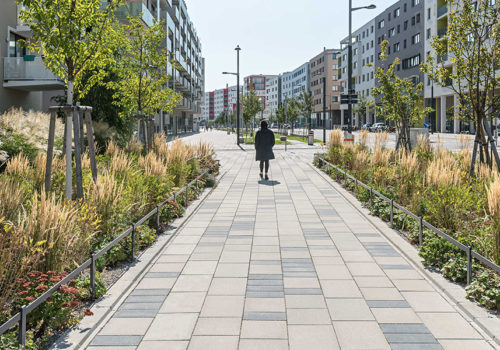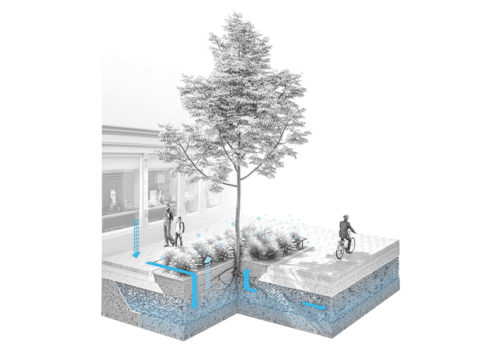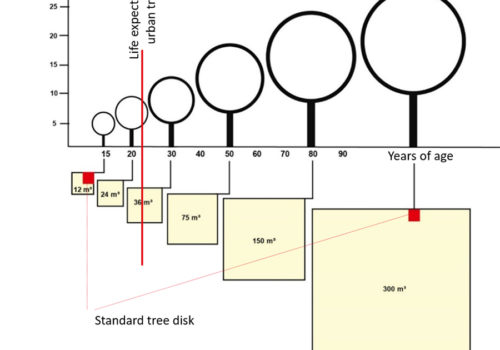beyond.aco | 26 April 2022 – On-Site
- Sonnenallee, Vienna
- Sponge City Schematic Illustration | © 3:0 Landschaftsarchitektur
- Sponge City | © LWG_Veitshoecheim
- Maria Tusch Straße, Vienna
- Daniel Zimmermann, 3:0 Landschaftsarchitektur | Photo: Julia Stix
- Christoph Peiritsch, ACO | Photo: Thomas Magyar
Daniel Zimmermann (3:0 Landschaftsarchitektur, AT-Vienna)
Sponge Cities for Trees
THE PRINCIPLE
Urban trees have a positive influence on the microclimate. They reduce wind speeds and provide shade. Through evaporation, they extract sensible heat from their surroundings and increase humidity. The perceived ambient temperatures are reduced. This is why vital trees are among the most effective means of combating local summer overheating – the so-called “urban heat-island effect”.
The sponge city principle for trees is an innovative system that enables the healthy development of large-crowned trees in paved areas and creates underground retention space for rainwater, thus ensuring the survival of urban trees in the street space.
If the root zone of trees is located under paved surfaces (sidewalks, parking lots, roads), the road substructure must have a suitable structure that meets both the technical requirements of road construction and the biological demands of trees. Creating retention space for precipitation water relieves the burden on the sewer system and provides trees with water even during dry periods.
FACTS
Climate change is taking place. Hot, dry summers increase and will bring many more heat days and tropical nights. Locally occurring heavy rain events will more frequently overload sewer systems and cause flooding. Local governments must develop strategies for these consequences of climate change.
Climate forecasts for the next decades indicate that the climate crisis will worsen. To keep our settlement areas livable, administrative and planning bodies must respond. Actions that are to have an effect in the future must be set today.
CHALLENGES
Trees reach their full capacity against the effects of climate change only after about 30 years, when they have developed a large crown. However, crown size is directly related to root volume. In practice, we find in cities and towns too small tree pads, unsuitable substrate, soil compaction and polluted street water. The trees get stuck in their development after a few years, cause increased maintenance effort and often die. In addition, the roots often cause considerable damage to municipal infrastructure (broken road surfaces, ingrown pipes).
Most street trees currently only reach an age of 20 to 30 years and remain small. They cannot come close to fulfilling their potential for mitigating the effects of climate change! With the sponge city principle, the tree discs can be kept smaller on the surface, as water and air are provided for the trees under the paved surfaces. Precipitation is directed into the underground retention space of the sponge city, bound to soil particles and stored until it is evaporated by the trees. Excess water infiltrates or is drained away. This creates more scope for the design of public space.
The exciting topic will be presented in more detail both in theory and by means of two practical examples: Urban development using the example of the “Quartier am Seebogen” and the implementation in existing surroundings using the example of the city of Graz.
About Daniel Zimmermann (3:0 Landschaftsarchitektur, AT-Vienna)
We do have solutions.
We just have to dare to implement them in our cities.
Blue-green infrastructure helps!
Landscape architect and graduate engineer Daniel Zimmermann lives and works in Vienna, Austria. His office “3:0 Landscape Architects”, which he founded in February 2000 together with Clemens Lutz and Oliver Gachowetz in Vienna after attending the Horticultural School in Vienna-Schönbrunn, the University of Natural Resources and Life Sciences in Vienna, the Vienna University of Technology and the University in Hanover, has been very successful for years. It specializes in public projects, the design of large urban open spaces, such as parks, squares and streets, and especially trees. In recent years, adaptation to climate change has become a major focus of the office.
The contemporary use of plants is of particular concern to Daniel Zimmermann, and so, in addition to his other responsibilities, he is also involved in the topic of the urban tree and the sponge city in Austria. He is a founding member of the Sponge-city working group (Sponge-city for trees, 1998) and a member of the ÖGLA (Austrian Society for Landscape Architecture). In his opinion, climate-sensitive planning urgently needs a paradigm shift in order to fundamentally maintain the current quality of life.
He has held a visiting professorship at the Landscape Planning and Garden Art Research Department focusing on “Landscape Architecture as a Means of Climate Change Adaptation” at the Vienna University of Technology since 2021 and has won numerous competitions with his office. Most recently, it won first prize in 2021 with the redesign of the forecourt in front of the Haus der Wiener Wirtschaft. Also first prize was won by “3:0 Landschaftsarchitekten” for the invited single-stage realization competition “Zentrale Rotes Kreuz” in Styria. Through the “well thought-out arrangement and positioning of the building structures,” the office’s design created space for a spacious forecourt in the middle of a possible neighborhood park, in keeping with the flow of visitors and employees. About the competition entry it says in the justification: “Such a composition creates more than just the fulfillment of the space program. It gives the building an appropriate positive appearance, and conveys transparency, openness, and plenty of space both inside and out.”











